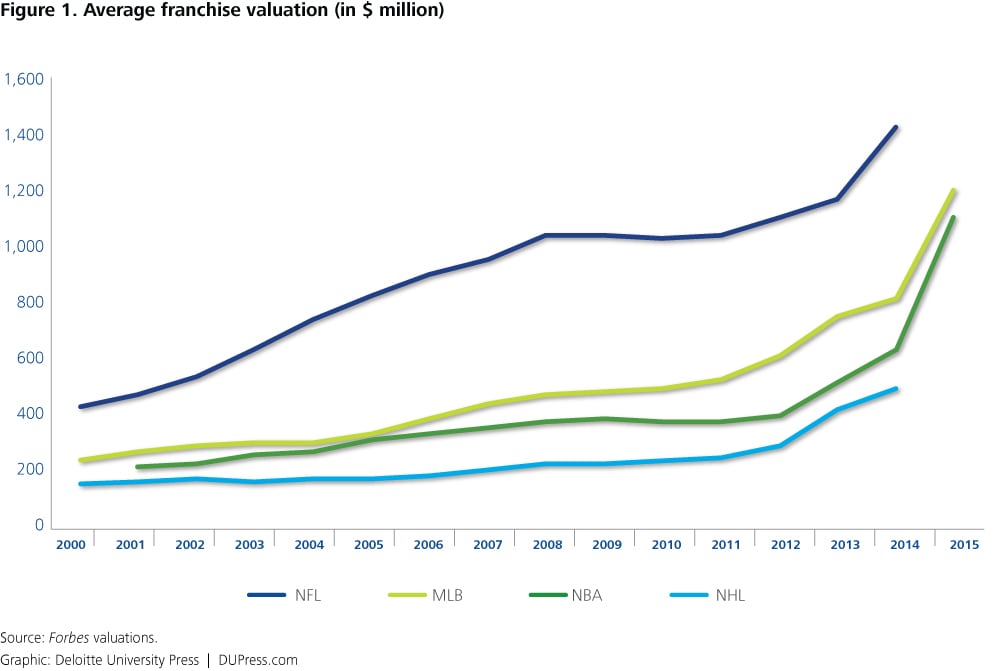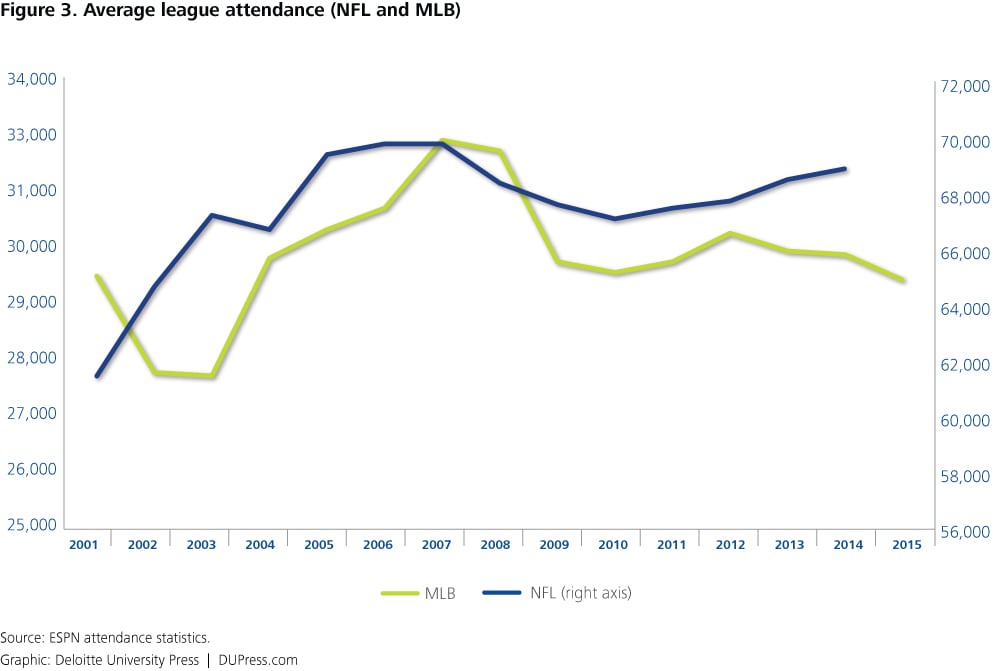Behind the Numbers: Professional sports and the merits of being big and connected has been saved

Behind the Numbers: Professional sports and the merits of being big and connected
08 August 2015
The NBA is the only major professional sports league that has set an attendance record over the last couple of years, but the big 4—NFL, NHL, NBA, and MLB—continue to enjoy impressive growth. A recent surge in average valuation across all four leagues has likely been driven by cheap credit, a bull run in the equity market since 2009, and ever-larger television broadcast deals.
Explore
View the Behind the Numbers collection, a monthly series from Deloitte’s economists.
Professional sports are a longstanding staple of the American experience. The games pass down like language and imprint themselves as heritage, so many of us learn to love the pastimes and idolize their champions from an early age. Professional leagues grew into big businesses that are voraciously consumed by a large and demographically diverse audience. Because of their broad appeal and visibility, professional sports leagues also became coveted ground for advertisers.
Four professional leagues in particular—The National Football League (NFL), Major League Baseball (MLB), the National Basketball Association (NBA), and the National Hockey League (NHL)*—capture a great deal of attention in the United States. All four leagues have enjoyed steady growth over the last several years, and they spend most of their time being the biggest they’ve ever been. As in many industries, the major professional leagues are being profoundly reshaped by technologies that change the ways they engage with fans and businesses.
Where does the money come from?
Professional spectator sports have four main revenue streams: television broadcast, corporate sponsorship, merchandise, and ticketing. While television broadcast and corporate sponsorship are usually governed by long-term deals, merchandise and ticketing are more closely dependent on disposable income and fan loyalty.
First, there is the ticket revenues that live games generate. On average, an NBA game was attended by more than 17,000 fans during the 2014–15 season at an average ticket price of $54.1 Additionally, stadiums and arenas bear the name of big businesses that pay millions to purchase naming rights for a fixed period of time. For example, MetLife Inc. committed to pay $16 million a year for 25 years for the naming rights of the home of the New York Giants and the New York Jets.2 Fans also purchase merchandise, including jerseys, hats, socks, cups, keychains, and even phone covers, providing a healthy supplement to ticket sales. Then there is the long list of corporate sponsors that pour in money in exchange for exposure to potential consumers. The MLB earned $695 million in sponsorship revenue in 2014.3 Finally, since millions of fans watch live games on television, television networks ink multiyear billion-dollar deals with professional leagues in exchange for broadcast rights. For instance, the NHL earns $200 million annually from the sale of television broadcast rights in the United States.4 Broadcasters cover the cost of buying rights with advertisement revenue.
The big four professional leagues are bigger now than ever before
The four major professional leagues in the United States (with a limited degree of participation from Canada) are not on an equal footing. Each league appeals to a different fan base, spans a different season (although they increasingly overlap), and operates on a different scale. For example, the NFL is by far the largest league in terms of valuation and revenue. Similarly, attendance in the NFL and the MLB far outnumber the NBA and the NHL. Furthermore, franchises within each league differ widely in terms of value and revenue.
However, despite the differences among the leagues, valuation and revenue have trended upward over the past 15 years, and both are at all-time highs.5 For revenues, the rise has been steady; for valuation, growth was fairly stagnant during the Great Recession (2007–2009) before resuming an upward trend (figures 1 and 2). Part of the reason for revenues holding up so well is that leagues are usually covered by multiyear broadcast and sponsorship deals. Another less-tangible factor that may contribute to resilience is steadfast fan loyalty. In fact, keeping the fans engaged is critical to the future of the sector. In terms of value per dollar of revenue generated, the NFL is currently only marginally above its 2008 level, though it is by far the most valuable on an absolute dollar basis. However, the MLB, NBA, and NHL have all experienced big increases in value per dollar of revenue over their 2008 levels with most of the increase happening after 2011.
 Average valuation remained rather flat between 2008 and 2011. However, the recent surge in average valuation across all four leagues has likely been driven by cheap credit, a bull run in the equity market since 2009, and ever-larger television broadcast deals.
Average valuation remained rather flat between 2008 and 2011. However, the recent surge in average valuation across all four leagues has likely been driven by cheap credit, a bull run in the equity market since 2009, and ever-larger television broadcast deals.
Technology is changing the "playing screen"
Consumption of professional sports extends far beyond the live experience. In fact, even as valuation and revenue continue to climb, none of the four major professional leagues, except for the NBA, have seen record-breaking attendance in the last couple of seasons (figures 3 and 4). Average attendance at both the NFL and the MLB is below 2007 levels while the NHL has experienced a decline in average attendance since the 2012–13 season.
With the proliferation of alternative viewing devices, the consumption of professional sports has extended beyond the television to smaller screens—the smartphone and tablet. Smartphone penetration in the United States stands at 75 percent as of Q3 20146 and is set to grow even higher. The fact that smartphone penetration was just 10 percent in 2008 puts things into perspective.7 Moreover, the rapid growth in the use of smartphones is accompanied by a similar surge in tablets (46 percent as of Q3 20148) and broadband access (78 percent as of Q3 20149). These changes are evident in the behavior of sports fans. For example, 52 percent of all sports fans say they will use a smartphone or a tablet to access sports-related content while watching televised sports,10 up from 36 percent in 2012.11 Moreover, 66 percent of devoted fans go online at least once a day for sports content.12 This is indicative of the emergence of the two-screen experience as well as a demand for digital access to sports content.
The rising dominance of the smartphone is also bringing social media into the forefront of sports. Accessing real time updates and highlights on social media is growing rapidly. Twitter Amplify, for example, aims to “harmonize the two-screen experience,”13 allowing for highlights and instant replays to be distributed to audiences via Twitter conversations while watching televised action (or from inside a stadium).
In the digital space, Internet streaming of live games, which bypasses the traditional route of television distributors, is an area of expansion. The NFL’s recent agreement to stream a live regular-season game in October 2015 is an example.14 The MLB is also taking steps toward changing local blackout rules and allowing live streaming of home games (the MLB does not allow live streaming of home games so as to protect broadcast agreements with regional sports networks).15
The overlap of mobile, digital, and social media technology is not only changing the way sports is consumed but is also allowing fans to get in on the action. At the 2015 Super Bowl, the NFL launched a stadium application that allowed spectators to watch instant replays from a choice of camera angle (in addition to watching commercials on their smartphones). Greater participation is also being fostered by online fantasy leagues, which are now multibillion-dollar sub-sectors (It is estimated that the size of the fantasy football market is anywhere between $40 billion and $70 billion.).16In fact, the home stadium of the San Francisco 49ers even houses a fantasy football lounge in partnership with Yahoo.17
Sports and technology are a winning combination for business
The cornerstone of success in the professional sports sector is deeper engagement with the fans. Technology is creating opportunities for growth in this sector by facilitating just that. The proliferation of on-the-go access to sports content is allowing professional sports leagues and franchises the opportunity to interact more closely with their fan base. Wider and deeper fan engagement can result in enhanced loyalty, which is beneficial since engaged fans are likely to spend more time and money on sports. Anytime access, stronger loyalty, and the likelihood of increased spending makes the professional spectator sports platform all the more attractive to large corporate sponsors that are likely to be more willing to part with dollars for exposure. The end result will likely be more money flowing into the sports ecosystem.
© 2021. See Terms of Use for more information.





